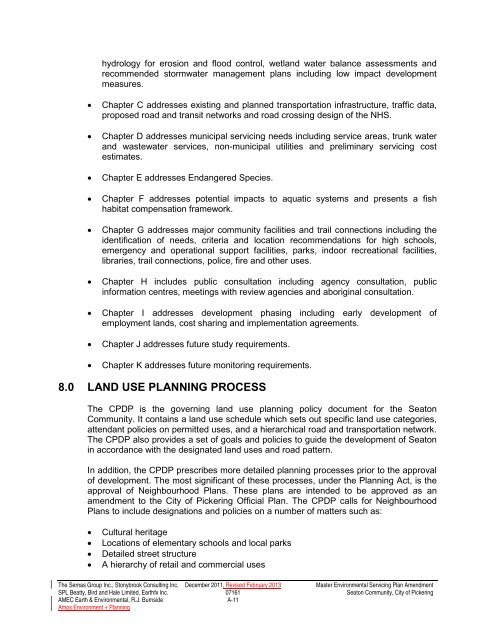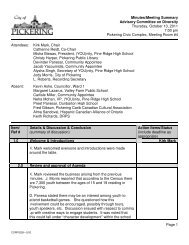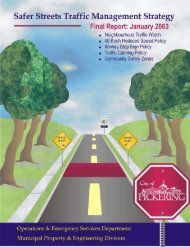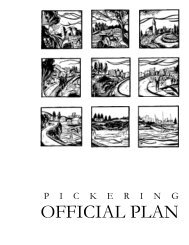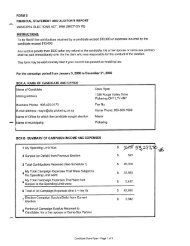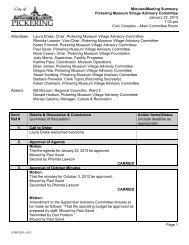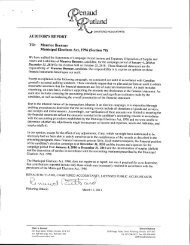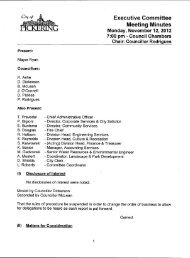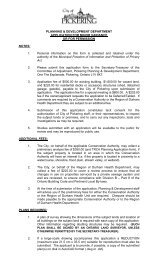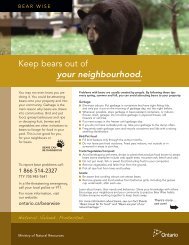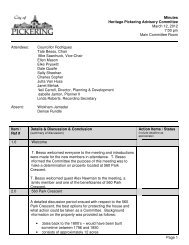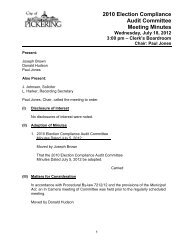Chapter A - Introduction - City of Pickering
Chapter A - Introduction - City of Pickering
Chapter A - Introduction - City of Pickering
You also want an ePaper? Increase the reach of your titles
YUMPU automatically turns print PDFs into web optimized ePapers that Google loves.
hydrology for erosion and flood control, wetland water balance assessments and<br />
recommended stormwater management plans including low impact development<br />
measures.<br />
• <strong>Chapter</strong> C addresses existing and planned transportation infrastructure, traffic data,<br />
proposed road and transit networks and road crossing design <strong>of</strong> the NHS.<br />
• <strong>Chapter</strong> D addresses municipal servicing needs including service areas, trunk water<br />
and wastewater services, non-municipal utilities and preliminary servicing cost<br />
estimates.<br />
• <strong>Chapter</strong> E addresses Endangered Species.<br />
• <strong>Chapter</strong> F addresses potential impacts to aquatic systems and presents a fish<br />
habitat compensation framework.<br />
• <strong>Chapter</strong> G addresses major community facilities and trail connections including the<br />
identification <strong>of</strong> needs, criteria and location recommendations for high schools,<br />
emergency and operational support facilities, parks, indoor recreational facilities,<br />
libraries, trail connections, police, fire and other uses.<br />
• <strong>Chapter</strong> H includes public consultation including agency consultation, public<br />
information centres, meetings with review agencies and aboriginal consultation.<br />
• <strong>Chapter</strong> I addresses development phasing including early development <strong>of</strong><br />
employment lands, cost sharing and implementation agreements.<br />
• <strong>Chapter</strong> J addresses future study requirements.<br />
• <strong>Chapter</strong> K addresses future monitoring requirements.<br />
8.0 LAND USE PLANNING PROCESS<br />
The CPDP is the governing land use planning policy document for the Seaton<br />
Community. It contains a land use schedule which sets out specific land use categories,<br />
attendant policies on permitted uses, and a hierarchical road and transportation network.<br />
The CPDP also provides a set <strong>of</strong> goals and policies to guide the development <strong>of</strong> Seaton<br />
in accordance with the designated land uses and road pattern.<br />
In addition, the CPDP prescribes more detailed planning processes prior to the approval<br />
<strong>of</strong> development. The most significant <strong>of</strong> these processes, under the Planning Act, is the<br />
approval <strong>of</strong> Neighbourhood Plans. These plans are intended to be approved as an<br />
amendment to the <strong>City</strong> <strong>of</strong> <strong>Pickering</strong> Official Plan. The CPDP calls for Neighbourhood<br />
Plans to include designations and policies on a number <strong>of</strong> matters such as:<br />
• Cultural heritage<br />
• Locations <strong>of</strong> elementary schools and local parks<br />
• Detailed street structure<br />
• A hierarchy <strong>of</strong> retail and commercial uses<br />
The Sernas Group Inc., Stonybrook Consulting Inc. December 2011, Revised February 2013 Master Environmental Servicing Plan Amendment<br />
SPL Beatty, Bird and Hale Limited, Earthfx Inc. 07161 Seaton Community, <strong>City</strong> <strong>of</strong> <strong>Pickering</strong><br />
AMEC Earth & Environmental, R.J. Burnside A-11<br />
Amos Environment + Planning


